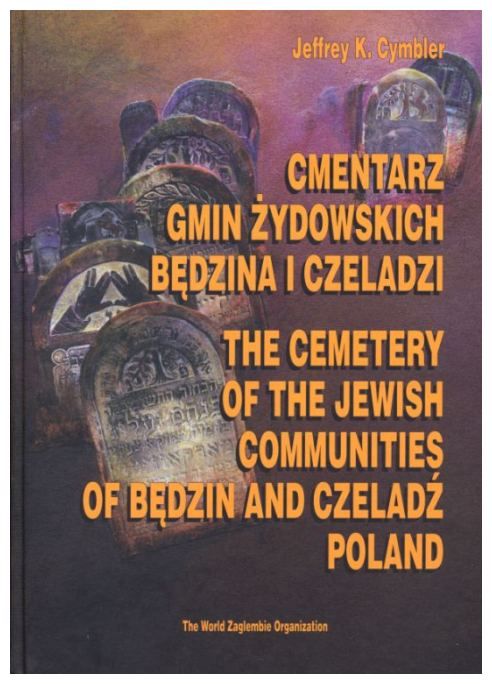The History of the Będzin-Czeladź Cemetery Indexing Project

By Jeffrey K. Cymbler
In 2003, I arranged to have a graduate of the Jagiellonian University in Kraków, Krysztof Adamczyk, photograph each tombstone with a digital camera which I provided. The tombstones were individually photographed over a period of months in a systematic manner so that the location of each tombstone could later be determined in sequence. Approximately 3200 photographs were taken.
I reviewed each image and translated, transliterated and extracted all of the relevant data and information in the inscriptions of each tombstone. Ada Holtzman, Orna Neiderman, Connie Newhan and I then entered my handwritten extractions into an Excel database. Ada and I also converted all Hebrew dates on the tombstones into non-Hebrew dates. All proofreading and rechecking the database entries against the photographs was done by me and only I am to blame for any errors that may not have been caught.
Some photographs were not clear enough to fully decipher either because of the quality of the photo or because the eroded inscription on the tombstone. Therefore, I spent three full days in the cemetery inspecting dozens of tombstones and also verifying the row numbers of all the tombstones.
While doing on-site verification in the cemetery, I stumbled upon additional tombstones that had been either buried by soil and decaying leaves or overgrown by vegetation. The information from these additional tombstones was then inserted into the database.
In the course of reviewing the digital images, it became evident that during the course of the cemetery’s renovation in 1988, different parts of broken tombstones had been cemented to the ground in separate locations. In many cases I have noted this observation in the “Notes” column.
I created the sketch map of the cemetery to facilitate finding tombstones in the cemetery by mapping out the corner graves on each row of the cemetery.
It is my hope that this book will assist people in locating the tombstones of their family members for many years to come.


How to Read the Database of Tombstones
The following descriptions and explanations apply primarily to the printed version of the database in “The Cemeteries of the Jewish Communities of Będzin and Czeladź, Poland.”
The database catalogue of the tombstones in the book is divided into three sections.
- A listing of all the tombstones on the left hand side of the cemetery.
- A listing of all the tombstones on the right hand side of the cemetery. Most of the tombstones on the left hand side are of women and most of the tombstones on the right hand side are men. (In almost all cases where today a man’s tombstone is on the left hand side of the cemetery or a woman’s tombstone is on the right hand side of the cemetery, the tombstone is not situated in its original location.)
- An alphabetical index of the names listed in the first two sections. In addition to containing an index of surnames and given names, the index also lists women by their maiden names, if a maiden name is inscribed on the tombstone. At the end of the index there is an alphabetical listing of given names inscribed on partially destroyed tombstones where the surname is now missing. In some cases where the surname is missing, I hope that people may be able to locate a tombstone by only the given name.
Therefore, to locate a particular tombstone listed in this book, review the alphabetical index of names. Next to the name you will find the Reference Number. Then go to the first two sections of the database and locate the Reference Number on the far left column.

Sample page “The Cemetery of the Jewish Communities of Będzin and Czladz” (click to view full-size image)
Reference Numbers
The numbers on the far left column of the database refer to the Reference Numbers of the original digital photographs of the tombstones. These numbers have no connection with any numbering that may be found on the tombstones.
Row Numbers
There are almost 3200 tombstones remaining in the cemetery. Unfortunately, the task of mapping the entire cemetery was too much of a challenge. Thus, I endeavored to chart, as best possible, the row number location of each tombstone. The tombstones are listed in this book in the order that they appear in the cemetery.
The first tombstone listed in each row is located next to the center path of the cemetery. Thus, to find a particular tombstone in the cemetery look for the first tombstone listed for that row. Verify that you have found the correct row by the name that should be on the corner (first) tombstone. The map in this book shows the name on each corner tombstone on every row at the center path. Once you have found the correct row, then count how many tombstones from the corner tombstone the one you are looking for is located.
The notation 45R, for example, denotes row 45 on the right side and 45L denotes row 45 on the left side. The row numbers on the right and left hand side do not correspond with one another. Thus, row 45 on the right is not directly across from row 45 on the left.
In total I have counted 88 rows on the men’s side and 91 rows on the women’s side. There is a large open area in the middle of the cemetery on both the men’s and women’s sides. After the open area the first row on the right is number 53 and the first row on the left is number 51
Surnames
Most of the tombstones are inscribed in Hebrew and/or Yiddish with Hebrew letters. All the surnames have been transliterated into Polish spellings. Thus, for example, the Polish spellings for the surnames Goldstein, Lefkowitz, Friedlander, Sherer and Katz are Goldsztajn, Frydlender, Szerer and Kac.
Of the almost 3200 tombstones remaining in the cemetery approximately 900 have been destroyed or partially destroyed and surnames are no longer visible. Many tombstones are missing surnames, given names, names of father’s and/or dates of death. With access to the death records (akta zgonów) in the Czeladź and Będzin Civil Records Offices (Urzad Stanu Cywilnego) town halls much of the missing information that the Nazis and vandals have destroyed in the cemetery could be ascertained. For information on how to access these records, write to [email protected]
Given Names
In most instances the Hebrew and Yiddish given names inscribed on the tombstones have been transliterated into English spellings. I have done this because in most instances the given names inscribed on the tombstones are not Polish names but rather Hebrew or Yiddish names. For example, although many people may have been known by Polish names, e.g., Regina, Hela, Mosziek, Jakub, or Lejbus, on their tombstones, their names were inscribed in Hebrew or Yiddish as Rivka, Chaya, Moshe, Yakov or Leib. Since I was transliterating Hebrew and Yiddish given names – not Polish given names — I transliterated these names into English spellings.
Dates
The vast majority of the tombstones are only inscribed with Jewish calendar dates. Secular dates of death are listed infrequently. In this book all the Jewish dates have been converted into secular dates. However, it is important to note that in the Jewish calendar the day begins at sunset in the evening and not at midnight. Therefore, if a person died in the evening at any time between sunset and midnight, the actual secular date of death should be one day earlier than as noted in this book. The only way to determine the actual secular date of death would be to locate the death certificate in the Civil Records Office (Urzad Stanu Cywilnego) of the town where the death was recorded.
Numbering of the Tombstones
As tombstones were erected in the cemetery, each tombstone was assigned and inscribed with a number. Indeed, on many of the tombstones the original inscribed tombstone numbers can still be found. In many instances, but not all, if the tombstone has a number engraved on it, it has been noted in this book. No attempt has been made to note every number inscribed on every tombstone because in many cases the numbers were inscribed on the very top or bottom part of the tombstone and these parts were often not photographed. In those cases where the tombstone number has been recorded, the notation can be found in the Notes column as “M__”. Thus, M567 means that this tombstone has the number 567 inscribed into the tombstone.
It should be noted that the highest tombstone number recorded is number 4018 dated December 22, 1942. This would seem to indicate that at one time there may have been more than 4000 tombstones in the cemetery. Today there are fewer than 3200 tombstones remaining in the cemetery. A visitor to the cemetery will note that there are several piles of broken tombstones throughout the cemetery which theoretically, if separated and photographed, could be put back together like a jigsaw puzzle.
Notes
The column on the far right is the “Notes” section. If a tombstone is destroyed and there is no information that can be read on what remains of the tombstone, the letter “D” is shown to indicate that the tombstone is destroyed. If the tombstone is only partially destroyed and some information can be read on the tombstone, then the letters “PD” are shown to indicate that the tombstone is partially destroyed.
Many of the tombstones have their original numbers on the stone. Where I have noted the inscribed number from a tombstone, the number is listed in the Notes column with the letter “M” preceding the number. The letter “M” in the notes column stands for the word “matzevah” or tombstone.
There are several symbolic tombstones in the cemetery that were erected by family members after the Holocaust. Symbolic tombstones are noted with the letters “SM.”
The search process
The indices to the matzevot have been integrated into the JRI-Poland general database.
The JRI-Poland search page allows you to narrow the search by entering “????” in the “Town” field. If a match in the Cemetery database is found, it will be identified in a separate table in the search results.
Following up on a successful JRI-Poland search of indices of graves at the Będzin-Czeladź Jewish Cemetery
JRI-Poland has no additional details or photographs associated with these burial records other than included in this database or the book in which this data was initially documented.
Sources and Additional resources
Books:
- The Cemetery of the Jewish Communities of Będzin and Czeladź Poland by Jeffrey K. Cymbler. Published by Wydawnicwto “Hagada” ul. Monisuszki 15/40, 31-523 Krakow, Poland. Email [email protected]
Websites:
- We Remember Jewish Będzin; We Remember Jewish Czeladź www.zchor.org/czeladz/czeladz.htm
- Cmentarze zytdowski w Polsce http://www.kirkuty.xip.pl/bedzinang.htm
- International Jewish Cemetery Project (International Association of Jewish Genealogical Societies) http://www.iajgsjewishcemeteryproject.org/poland/bedzin-katowickie.html



